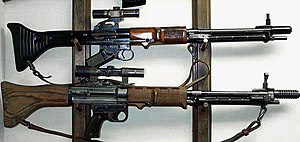FG 42
| Fallschirmjägergewehr 42 | |
|---|---|

Both early (top) and late-war (bottom) variants of the FG 42.
|
|
| Type | Automatic rifle or Battle rifle |
| Place of origin | Nazi Germany |
| Service history | |
| In service | 1942–1945 |
| Used by | See Users |
| Wars | World War II |
| Production history | |
| Designer | Louis Stange |
| Designed | 1941–1942 |
| Manufacturer |
Rheinmetall (limited) Heinrich Krieghoff Waffenfabrik, L. O. Dietrich (limited) |
| Produced | 1943–1945 |
| Variants | Early model (original Rheinmetall-Borsig design) Late model (Krieghoff revision) |
| Specifications | |
| Weight |
Ausführung "E": 4.2 kg (9.3 lb) Ausführung "G": 4.95 kg (10.9 lb) |
| Length |
Ausführung "E": 945 mm (37.2 in) Ausführung "G": 975 mm (38.4 in) |
| Barrel length | 500 mm (19.7 in) |
|
|
|
| Cartridge | 7.92×57mm Mauser |
| Action | Gas-operated, rotating bolt |
| Rate of fire |
Ausführung "E": ~900 rounds/min Ausführung "G": ~750 rounds/min |
| Muzzle velocity | 740 m/s (2,428 ft/s) (SmK bullet) |
| Effective firing range | 600 m |
| Feed system | 10- or 20-round detachable box magazine |
| Sights | Iron sights (all models); flip-up front post and folding rear diopter sight; ZFG42 or ZF4 scope |
The FG 42 (German: Fallschirmjägergewehr 42, "paratrooper rifle 42") is a selective-fire automatic rifle or battle rifle produced in Nazi Germany during World War II. The weapon was developed specifically for the use of the Fallschirmjäger airborne infantry in 1942 and was used in very limited numbers until the end of the war.
It combined the characteristics and firepower of a light machine gun in a lightweight form no larger than the standard-issue Kar 98k bolt-action rifle. Considered one of the most advanced weapon designs of World War II, the FG 42 influenced post-war small arms development, and most of its design was copied by the US Army when they developed the M60 machine gun.
At the time of the Battle of Crete (Operation Mercury), German Fallschirmjäger were equipped with the same assortment of small arms as the Heer, carrying only pistols and hand grenades on them during parachute jumps, with submachine guns, rifles and crew-served weapons stored separately in containers that were dropped from the wing of the exit craft. The German parachute harness, with a single strap attached to the body making the paratrooper land on his hands and knees in a forward roll, did not allow for heavier equipment such as rifles and machine guns to be safely carried during jumps. At Crete, long-range rifle and machine gun fire from dug-in Commonwealth defenders inflicted heavy casualties on the outgunned German paratroopers in the early stages of battle as they attempted to retrieve their support weapons from containers scattered all over the battlefield. These combat experiences demonstrated the need for a rifle that could be carried on the person of the paratrooper.
...
Wikipedia
